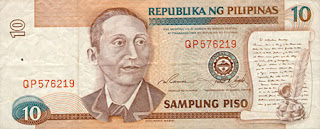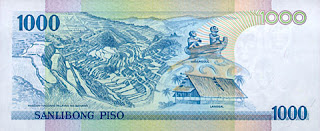Posted by gmygotravel
The currency in the Philippines is the Philippine peso (or piso), divided into 100 centavos (or centimo). Currently (January 2002), the U.S. dollar is worth about 52 pesos, and the euro about 46 pesos. Current are coins of 1, 5, 10, and 25 centavos and 1 and 5 pesos, and bank notes of 5, 10, 20, 50, 100, 200, 500 and 1000 pesos. The 5 peso note is no longer printed, but still legal tender.
Banknotes
5 Peso - The 5 peso note depicts Emilio Aguinaldo, a Philippine resistance hero who first fought the Spanish, and later the American occupiers of the country. The first president of the Philippines. On the reverse you can see the proclamation of Philippine independence, from the balcony of Aguinaldo's house. You won't find this note much in circulation today, as it has been replaced by a 5 peso coin.
10 Peso - The 10 peso note depicts Apolinario Mabini and Andres Bonifacio. You can also get across an older version with only Mabini. On the reverse is the church of Barasoain.
20 Peso - The 20 peso note depicts Manuel L. Quezon. On the reverse you can see the Presidential Palace, the Malakañang.
50 Peso - The 50 peso note depicts Sergio Osmeña. On the reverse you can see the Executive House. Be careful not to confuse it with the 20 peso note, as the color is nearly the same.
100 Peso - The 100 peso note depicts Manuel A. Roxas. On the reverse you can see the buildings of the Philippine National Bank.
200 Peso - Introduced in 2002, the 200 peso note commemorates the the June 12 Independence Day, and the EDSA II uprising. It depicts president Diosdado Macapagal, the father of the current president, Gloria Macapagal Arroyo, who is also depicted on the back of the note.
500 Peso - The 500 peso note depicts Beningno S. Aquino Jr.
1000 Peso - The 1000 peso note depicts Jose Abad Santos, Vincent Lim, and Josefa Llanes Escoda. On the reverse you can see the rice terasses in Banawe, and some tribal artifacts. You won't come across this note very often, and you shouldn't expect your taxi driver to have change from it.

 Flat blade plug
Flat blade plug Two round pins
Two round pins













































